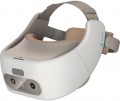Built-in memory
The amount of built-in storage installed in glasses.
Only independent devices are equipped with such a drive (see "Intended use") — it is used to store software firmware, as well as various additional content (applications, panoramic films, etc.). The larger the storage capacity, the more such content can be stored on the device; on the other hand, this characteristic directly affects the price. It is also worth considering that some models allow you to supplement the built-in storage with a memory card (for more details, see "Cart Reader").
For modern virtual reality glasses, the most modest volume is 16 GB — it is technically impractical to install smaller drives. In advanced models, this figure can reach 128 GB.
RAM
The amount of random access memory (RAM) installed in glasses.
This parameter is relevant only for independent devices (see "Intended use"). Theoretically, the more RAM in the gadget, the higher its power, the faster it is able to work and the better it handles with “heavy” tasks. However, in fact, this characteristic has more reference than practical value. Firstly, the capabilities of standalone glasses are also highly dependent on the processor and video adapter used. Secondly, the amount of memory is selected in such a way that the glasses are guaranteed to be able to cope with the tasks for which they were originally intended. Actually, problems can only arise with the launch of very demanding applications or resource-intensive video (for example, 4K panoramic videos); so paying attention to the amount of RAM makes sense only if you plan to use glasses for such purposes.
As for specific volumes, they in modern devices range from 2 to 4 GB.
Bluetooth
The presence of a
Bluetooth module in the glasses; The Bluetooth version to which this module corresponds can also be specified here.
Bluetooth is a technology created for direct wireless connection between various devices. This technology is found in all types of VR glasses (see “Purpose”), although most models with its support are independent devices. In any case, the most popular way to use Bluetooth in virtual reality glasses is to broadcast sound wirelessly. Moreover, the format of such a broadcast may be different, depending on the specifics of the glasses themselves. Thus, standalone devices broadcast the reproduced sound to external headphones. Models for PCs and smartphones may have built-in headphones, and here the sound is transmitted via Bluetooth to the glasses from an external device; Audio from the built-in microphone can be transmitted in the opposite direction.
In addition, there are other possible ways to use Bluetooth, such as directly exchanging files with another device or connecting game controllers. Such capabilities are found exclusively in stand-alone glasses; the specific functionality for each model should be clarified separately.
As for the versions, the oldest one used in VR glasses today is Bluetooth 3.0, the newest is Bluetooth 5.0. However, the differences between different versions for such devices are not fundamental; this information is provided mainly for reference purposes.
Microphone
The presence of
a microphone in the design of VR glasses.
This function is mainly equipped with models for PC / consoles (see "Intended use"). The built-in microphone is mainly used for voice communication in online games. At the same time, it often turns out to be more convenient than a desktop microphone or a microphone built into a headset: glasses can interfere with the comfortable wearing of a headset, and a desktop device is not applicable because at least the user’s head (or even the whole body) is constantly moving in VR games, and constantly it is impossible to be at the optimal distance from the microphone.
For added convenience, your own microphone can be made retractable or removable.

